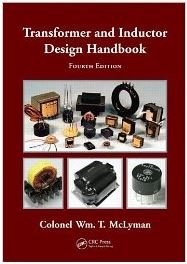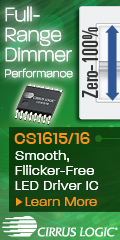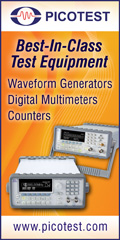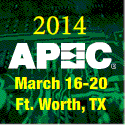 |
|
IN THIS ISSUE:
» From the Editor's Desk
» Demystifying PSRR Specifications For LDOs
» Hold-Up Modules Reduce Capacitance Requirements For High-Rel Power Supplies
» Video: Troubleshooting Distributed Power Systems: Using Current Injectors
» Semiconductors In The Efficiency Era:
GaN Suppliers Continue to Push the Performance Envelope
» Focus On Magnetics:
Association Supports North American Transformer Companies Through Networking, Education, And Technical Advancement
» Book Review:
Updated Magnetics Classic Offers Some Practical Info, But Little Insight In Theory
» New Power Products
» Other Top Power News
From the Editor's Desk David G. Morrison
Editor, How2Power TODAY
|
|

It’s natural to expect component specifications to improve over time as new parts are developed. But sometimes the new and improved specifications are too good to be true. That may be the case with the PSRR specs of newer LDOs. As Kern Wong explains in one of this month’s features, datasheets that plot PSRR at frequencies beyond a megahertz are misleading. As Kern says, “The truth is that practically all LDOs on the market are incapable of rejecting supply noise effectively beyond a few megahertz. Above the device’s loop bandwidth frequency, vendors are not really measuring the LDO’s ability with respect to PSRR, but that of the COUT and companion impedances of the pass FET, plus circuit board parasitics.” This issue underscores the need for designers to understand how IC manufacturers are deriving their datasheet data and being able to assess whether the data really represents component performance accurately. This problem also lends credence to the notion that designers cannot rely too heavily on published data and must be prepared to gather their own. That is certainly the point of view taken in the ongoing video series by Steve Sandler whose latest installment offers designers insights into how current injectors may be applied to measuring the impedance of power circuits, but also to other critical tests such as measuring PSRR. This issue also features an article about hold-up modules, GaN power device news, and more. |

 |
 |

|
HOW2POWER EXCLUSIVE DESIGN ARTICLES 
|
Demystifying PSRR Specifications For LDOs
Kern Wong, Texas Instruments, Dallas, Texas The quest for lower-noise feedthrough over frequency in low-dropout regulator (LDO) circuits is driving designers of mobile devices, tablets, and portable instruments to seek LDOs specifying ever-higher levels of power supply ripple rejection ratio (PSRR). While an LDO PSRR figure at higher frequencies often relates to improved system performance due to increased bandwidth in noise rejection, its popularity has overshadowed the device’s native performance. A PSRR specification of ~10 MHz is often confusing, distorted, and unqualified. This article aims to clarify the LDO PSRR specification across the application’s frequency range of interest and dislodge common myths to help designers make intelligent LDO selections. In addition, proven solutions in the form of circuit recommendations and LDO device options are provided to help engineers achieve their design goals.
Read the full story…
|

An LDO’s open-loop gain falls and its PSRR declines over frequency. The PSRR action beyond 1 to 5 MHz
is primarily attributable to the feedbackdivider associated with the pass FET and to the output impedances on the PCB—not the LDO itself. |


An integrated hold-up module charges
the
hold-up capacitor to a much-higher
value
than the typical hold-up circuitry, increasing the amount of stored energy
for a given value of capacitance. |
Hold-Up Modules Reduce Capacitance Requirements For High-Rel Power Supplies
by Christophe Massenet, Gaia Converter, Summit, N.J..
When a power supply designer needs to comply with military standards, he may need to take into account the transparency or hold-up requirement. The transparency requirement is the minimum amount of time during which input power can go away but the equipment is expected to remain operational. This power interruption duration may range from 50 ms all the way to 1000 ms. The simplest way to achieve such a hold up function is to connect the input bus to a huge tank capacitor. Unfortunately, when typical hold-up circuitry is employed, the actual capacitors required to achieve the specified hold-up time can be quite large. However, an integrated hold-up module offers a space-saving alternative. By increasing the voltage to which the hold-up capacitor is charged, the module increases the stored energy for a given capacitance value, reducing the amount of capacitance needed to achieve a given hold-up time. This article assesses the impact of hold-up modules on mil/aerospace applications employing 28-V input dc-dc converters operating at different power levels.
Read the full story…
|

Video:
Troubleshooting Distributed Power Systems: Using Current Injectors
by Steve Sandler, AEi Systems and Picotest, Phoenix, Ariz.
Previous videos in this series discussed the use of vector network analyzers (VNAs) to measure impedance using one- or two-port configurations. This video discusses another method of measuring impedance—the current injector method. Although not quite as accurate as the two-port VNA impedance measurement, the current injection technique has advantages including wide range (approx. 1 milliohm to thousands of ohms), the ability to measure in-system, and a suitability for measuring low-power devices such as op amps, voltage references, and voltage regulators. In addition, current injectors can be used to carry out other types of tests such as non-invasively measuring PSRR, determining power integrity and signal integrity sensitivity, and in generating high-speed load steps. In this video, Steve Sandler discusses each of these current injector measurement capabilities and presents test examples that illustrate how designers can perform and interpret these measurements. Along the way, Sandler offers many test tips to help the engineer obtain the most accurate results.
Watch the video…
|

Current injectors are versatile test tools
for the power design lab. They can be
used to measure impedance over a wide
range of values, make measurements in
system, measure PSRR non-invasively,
determine power integrity sensitivity,
and
generate high-speed loads steps. |

 |  |

SEMICONDUCTORS IN THE EFFICIENCY ERA 
Sponsored by Cree
A monthly column discussing the latest advances in power semiconductor technology and devices |

GaN Suppliers Continue to Push the Performance Envelope
by Ashok Bindra, Technology Writer, Technika
After months of sampling its 650-V normally-off source-switched FETs (SSFETs), RF Micro Devices (RFMD) plans to ramp up production of these devices by early next year and the company has readied a boost circuit evaluation board to help designers evaluate these parts. The company is also developing another eval board incorporating a totem pole power factor correction (PFC) circuit, which is expected to be launched at APEC 2014. RFMD is also readying new members in the 650-V GaN family with a 1200-V version on the roadmap. Meanwhile, Efficient Power Conversion has extended its family of high-speed, high-performance eGaN FETs with the addition of third-generation devices with switching transition speeds in the sub-nanosecond range. The recently released EPC8000 devices are capable of hard switching above 10 MHz. Bindra discusses these and other GaN power developments in this month’s column. Read the full story…
| |


FOCUS ON MAGNETICS 
Sponsored by Payton Planar Magnetics
A monthly column presenting information on power magnetics design, products, or related technology |

Association Supports North American Transformer Companies Through Networking, Education, And Technical Advancement
by James C. Tabbi, The Transformer Association (TTA)
The electrical and electronic transformer manufacturing base in North America has been in constant flux for the past two decades. Dramatic economic, technological and social revolutions have driven much of this change. As we become more connected, mobile, and sustainable as a culture, our power electronics technology must keep pace through improvements in efficiency, size and cost. Vehicle electronics, wireless charging, wind and solar energy conversion and the smart grid are all placing new demands on inductive devices. The off shoring of much of the electronics value chain, and the consolidation of the on-shore manufacturing base has reshaped the face of transformer manufacturing in the U.S. In response to these challenges, an industry organization known as The Transformer Association has grown and evolved over the past 15 years, more than doubling its membership. Read the full story…
|

|


 |
 |
Book Review  |

|
Updated Magnetics Classic Offers Some Practical Info, But Little Insight In Theory
Transformer and Inductor Design Handbook, Fourth Edition. by Colonel Wm. T. McLyman, CRC Press, 2011, about 600 pages, hardback, ISBN: 978-1-4398-3687-3. Website: www.crcpress.com
Reviewed by Dennis Feucht, Innovatia Laboratories, Cayo, Belize
This book covers topics in transformer and inductor design and how they relate to various converter circuits. Included are magnetics fundamentals, magnetic materials, catalog material on cores, various aspects of transformer and inductor design, transductors for flyback and forward converters, input filter design, current, rotary, planar, autotransformer and saturable (magnetic amplifier) transformer design, the “quiet converter,” winding capacitance and leakage inductance, and a chapter titled “Derivations for the Design Equations.” While this book contains useful information, it seems to have little to offer a reader seeking a deeper understanding of the essential insights into magnetics and their use in converter circuits. Read the full story…
|

|

 — POWER PRODUCTS IN 3 IMAGES OR LESS — POWER PRODUCTS IN 3 IMAGES OR LESS 
|
 |
|

Texas Instruments’ TPS7H1101-SP
and TPS7H1201-HT LDOs.
|
Current-Sharing LDOs Double Current Capability For Harsh Environments
 Diagram: Rated for operation at temperatures as high 125°C and 210°C respectively, the 3-A TPS7H1101-SP and the 0.5-A TPS7H1201-HT are current-sharing LDOs that can each be paralleled to double their output current capability. Diagram: Rated for operation at temperatures as high 125°C and 210°C respectively, the 3-A TPS7H1101-SP and the 0.5-A TPS7H1201-HT are current-sharing LDOs that can each be paralleled to double their output current capability.
 Diagram: TI’s current-sharing LDOs come in a thermally enhanced ceramic flat-pack. Diagram: TI’s current-sharing LDOs come in a thermally enhanced ceramic flat-pack.
More details… |



International Rectifier’s R8
rad-hard trench MOSFETs. |
Trench Technology Boosts Efficiency, New Package Saves Space For Rad-Hard MOSFETs
 Graph: Described as the first rad-hard MOSFETs fabricated using trench technology, IR’s R8 devices boost the efficiency of buck converter designs by up to 6% when compared with designs using the company’s previous-generation, planar rad-hard MOSFETs. Graph: Described as the first rad-hard MOSFETs fabricated using trench technology, IR’s R8 devices boost the efficiency of buck converter designs by up to 6% when compared with designs using the company’s previous-generation, planar rad-hard MOSFETs.
 Diagram: Considered the industry’s smallest low-power, surface-mount power package, the SMD 0.2 reduces the R8 devices’ footprint by half in comparison with devices in the SMD 0.5 package. Diagram: Considered the industry’s smallest low-power, surface-mount power package, the SMD 0.2 reduces the R8 devices’ footprint by half in comparison with devices in the SMD 0.5 package.
 Graph: Fully characterized to 300 krads of TID and SEE with an LET of 81 MeV-cm2/mg, the R8 MOSFETs offer radiation performance similar to that of the company’s planar devices. Graph: Fully characterized to 300 krads of TID and SEE with an LET of 81 MeV-cm2/mg, the R8 MOSFETs offer radiation performance similar to that of the company’s planar devices.
More details… |


Dialog Semiconductor’s
iW1679
PWM controller.
|
Digital PWM Controller Cuts BOM Cost, Standby Power In Smartphones
 Diagram: To lower BOM cost in 10-W adapters and chargers, the iW1679 PWM controller directly drives a low-cost bipolar junction transistor rather than a more costly FET. Quasi-resonant operation enables high efficiency. Diagram: To lower BOM cost in 10-W adapters and chargers, the iW1679 PWM controller directly drives a low-cost bipolar junction transistor rather than a more costly FET. Quasi-resonant operation enables high efficiency.
 Photo: The controller comes in a standard 8-lead SOIC. Photo: The controller comes in a standard 8-lead SOIC.
More details… |

Efficient Power Conversion’s
EPC2018 eGaN FET. |
Enhancement-Mode GaN FET Delivers Extremely Low On-Resistance
 Photo: Offered in passivated die form, the EPC2018 is a 150-V enhancement-mode GaN-on-silicon FET specifying a maximum RDS(ON) of 25 mΩ with 5 V applied to the gate. Photo: Offered in passivated die form, the EPC2018 is a 150-V enhancement-mode GaN-on-silicon FET specifying a maximum RDS(ON) of 25 mΩ with 5 V applied to the gate.
More details… |

|
OTHER NOTEWORTHY NEW POWER PRODUCTS:
• Ericsson’s 3E* DC-DC regulator, the BMR461, is a 1-A digital point-of-load module that features dynamic loop compensation
• Maxim Integrated Products’ MAX17503 2.5-A 60-V synchronous buck converter is said to operate 50% cooler than any other industrial high-voltage dc-dc converter.
• Payton Planar Magnetics’s new Apple and Android APP enables power supply designers to communicate with Payton engineers and request RFQs for transformers or inductors in real time. To download the APP type "PAYTON RFQ" at Google Play or the Apple App Store.
|

|








|

 |
 |

OTHER TOP POWER NEWS |
|
 Lazar Rozenblat, founder of the popular smps.us site, recently introduced a small website offering reference and design information on power factor correction, both active and passive PFC. Lazar Rozenblat, founder of the popular smps.us site, recently introduced a small website offering reference and design information on power factor correction, both active and passive PFC.
 Dr. Franki N. K. Poon and Dr. Joe Liu of PowerELab will present two one-day seminars on “Understanding & Effectively Solving EMI for SMPSs and LED Drivers.” These classes will be presented December 6 in Shenzhen, China and December 13 in Shanghai, China. Dr. Franki N. K. Poon and Dr. Joe Liu of PowerELab will present two one-day seminars on “Understanding & Effectively Solving EMI for SMPSs and LED Drivers.” These classes will be presented December 6 in Shenzhen, China and December 13 in Shanghai, China.
 The upcoming ECS Fall 2013 meeting in San Francisco will feature multiple sessions on GaN and SiC power technology. See Symp. E3: GaN and SiC Power Technologies 3. The upcoming ECS Fall 2013 meeting in San Francisco will feature multiple sessions on GaN and SiC power technology. See Symp. E3: GaN and SiC Power Technologies 3.
|



ABOUT THIS NEWSLETTER: Thank you for reading HOW2POWER TODAY.
How2Power sends no more than one e-mail per month to registered users. Continuing your subscription ensures you'll receive future newsletters. Manage Your Subscription
©2013 All rights reserved. www.how2power.com
|